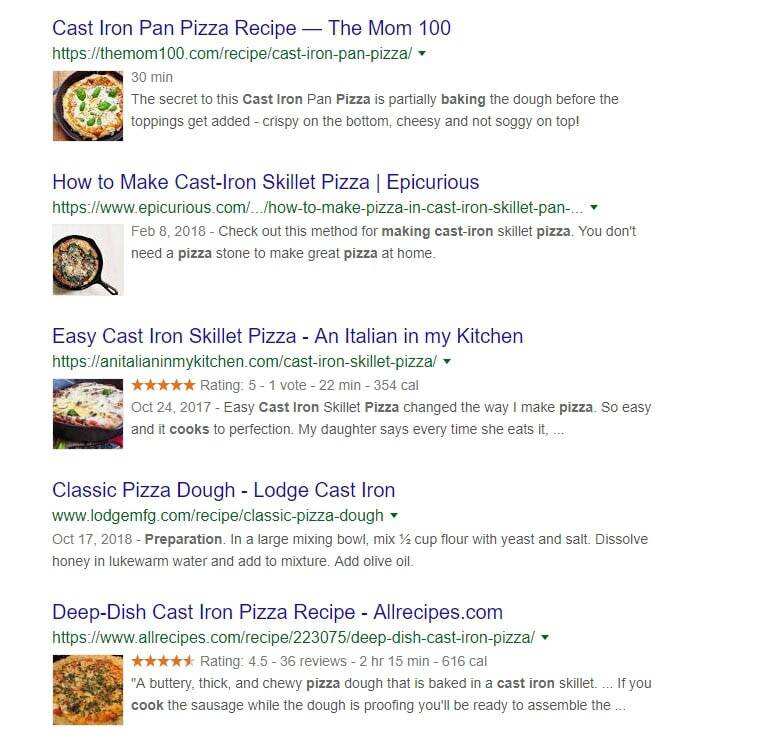
If you want your content to be found naturally in search engines, strong search engine optimization (SEO) basics are essential. However, despite our efforts to cater to Google’s robots, we still need to make sure that we pay special attention to the human factor.
Fortunately, a well-written meta-description can attract readers’ attention and convince them that your content will answer their questions and is worth their time. In turn, it can improve the natural click-through rate (CTR) of your site and help tell Google that your page is valuable.
In this article, we will introduce you to meta-description and its importance to your website. Then, we will share some important tips to help you write a better meta-description and improve your natural click rate.
Introduction of meta-description
A meta-description is a snippet of text under the title you see on the search engine results page (SERP), as shown in the following example:

The main purpose of a good meta-description is to let the reader understand the content of the web page. Of course, the title also plays a vital role here, but the information that a title can hold is limited.
Meta-descriptions can provide up to a few words to expand your web page content. You can write it yourself, or let the search engine generate it automatically based on the content of your page.
While it sounds convenient for search engines to do this work for you, we strongly recommend that you write your own meta-description. In this way, you have complete control over the content displayed on SERP and social media sites, while increasing your chances of attracting users.
Let’s look at an example of a meta-description of a particular series of shoes. You can see that the following meta-description is automatically generated, and it doesn’t give you much clues:

This is another result of the same product search, which uses a stronger meta-description:
It is important to understand that meta-descriptions only give you a limited number of characters to play with. On desktops, there can be up to 160 characters, and mobile phone users can only see 120 of them. Roughly speaking, this means that you have about two lines of text.
Why meta-description is important
SEO is about relevance. To get a ranking, you first need to produce high-quality content designed to answer a particular question or cover a topic thoroughly and accurately. In addition, there are a lot of SEO best practices, tips and tricks that can help you get a better ranking.
Some of the categories in which Google has used its algorithms to help them rank content in searches are called “ranking factors”. In fact, there are more than 200. Examples include keyword use, metadata, media use in content, backlinks and participation.
Although meta-descriptions themselves are not a “ranking factor”-because they do not directly affect the ranking of your pages-they can indirectly help you and encourage true human searchers to click on your results. this marks a higher level of user engagement and may affect your search location.
What should be included in the meta-description
There are not many two lines of text, but more often, it is enough to cover several key elements. Most commonly, this should include:
- What is your web page about?
- How can it benefit readers?
If the meta-description is too vague, then you don’t sell users the idea of visiting your site. Of course, you may still get clicks, but not as many as in other cases.
For example, you want to write a meta-description for the article you are reading. Here may be a not-so-good example.
Have you ever thought about what meta-description is? Don’t think about it, because we’ll tell you everything you need to know.
Although it hits the main theme of the article, it does not preview the actual content of the page very well. Now let’s do it again, keeping in mind the basic elements we need to include.
Meta-description conveys what your web page is about and can indirectly affect rankings. Learn how to write a perfect meta-description here.
The description is short and straight to the point, and we even have enough characters left to include a simple call to action (CTA). It may not win any literary prizes, but it will finish the work.
How to write a perfect meta-description
At this point, you know what the basic content of meta-description should include. Now, here are 10 tips that will help you really type out your meta-description.
1. Use related keywords
If you are reading this article, you may be familiar with the concept of key words. Ideally, you will naturally use key phrases in all your content, including in the metadata, as you described.
For example, if you are writing a recipe, you want to optimize the search term “how to cook healthy lasagna.” This is a term that is easy to use in meta-descriptions.
Learning how to cook healthy lasagna is easier than you think. Let’s take a look at a recipe that you can finish in two hours.
It is a SEO best practice to include keywords in your meta-description. It gives search engines a better understanding of what your content is.
However, as always, make sure these meta-keywords are natural. This means not stuffing your description with keywords.
In fact, Google recommends against using a long list of keywords in your meta-description. So make sure your description still looks like what humans (not robots) can write.
two。 Consider the number of meta-description characters
So far, most of the examples we have shown are well below the maximum number of characters for major search engines. You want to get some benefit from your meta description. However, in practice, the entanglement with the number of characters is not as serious as you think.
Based on our previous example of healthy lasagna recipes, you can easily expand its description to cover more information.
Learning how to cook healthy lasagna is easier than you think. In this recipe, we use eggplant instead of meat, which means it can be cooked faster and can be eaten by up to four people.
This example exceeds Google’s character limit for desktop and mobile meta-descriptions. In practice, it will be cut off and look like this.
Learning how to cook healthy lasagna is easier than you think. For this recipe, we use eggplant instead of meat, which means it will be cooked.
This passage still provides a lot of information, so you don’t necessarily need to change it. It is important that you include basic details at an early stage, so any cut-off information is just supplementary information.
You should also remember that Google does not recommend using very short meta-descriptions. While it’s good to be brief, the description of a sentence is unlikely to contain enough information for readers to click and browse.
3. Create a unique meta-description
When it comes to meta-descriptions, there are two potential duplications. It is good to avoid these two situations:
- Imitate the description of other websites
- Have several of your pages use the same description
In general, when it comes to SEO, repetition is almost always bad news. In addition, if you have several pages competing for the same search term, it may hurt your click-through rate. For this reason, Google recommends that you do not reuse the same meta-description in different pages or articles.
For practical purposes, there is no reason why all your pages should not have a unique meta-description. If you spend more than a few minutes writing one, you may be worrying too much.
4. Write a persuasive copywriter
Most meta-descriptions are boring, at least in terms of language. It is not suitable for innovation to cover so much information in such a limited space.
One of the ways to make your meta-description stand out is to use compelling language. To do this, take a look at what other websites say about the keywords you want to rank. For example, you are looking for a recipe for cast iron pizza.
Much of the content will be similar, which means that their meta-descriptions will also share elements. However, not all descriptions are equally valid:

In the above examples, some of our favorite click-through rates include the words “crispy”, “buttery” and “chewy”. There are five results, but the first and last stand out because of their vocabulary choices.
Think of it this way-if you stare at that page and try to decide which recipe to follow, you may choose a recipe that sounds more delicious. At this stage, you don’t know how good this recipe will be, so your only indicator is the selection of words in title tags, pictures, and meta descriptions.
5. Be specific and concise
A vague meta-description is unlikely to get many clicks. If readers don’t know what to expect from the beginning, they have no incentive to spend energy visiting your web page and reading your content.
Although the meta-description is short, you can incorporate details into it by using picky words. Using precise language can convey the main points of your content in no more than the number of characters.
Google provides an example of this highly specific meta-description for a product page:

When writing a meta-description for a blog post, you can include a quick summary of its title so that the reader has a detailed overview of the content:

In addition, you can also summarize a key point in your article in the meta-description. The specific method will depend on the nature of your article and which information is most relevant to the reader.
6. Make your meta-description operable
Simply write a summary of the statement of your blog post to tell potential readers what it is about. However, if you don’t add a little excitement to your meta-description, it may feel ordinary or even boring.
You can solve this problem by making your meta-description operational. This means that when readers click on the title and enter your article, it will prompt them to actually do something.
In the following meta-description example, the site attracts readers by encouraging them to “try these tips”, while also explaining the benefits of the article:

Using CTA in your meta-description can attract readers’ attention when they are scanning search engine results. It can also tell them more about what they should expect from your content.
There are several ways to make your meta-description operational. You can add a direct CTA at the end of the description, as in the example above. In addition, you can also use the active voice throughout the process to stimulate readers’ interest and encourage them to click and browse:

Both methods are effective and can effectively attract readers to your site, so it’s a matter of preference. In all cases, however, we recommend that you stay as far away from passive language as possible.
7. Considering your target audience
When writing a meta-description of your content, it is also important to consider your target audience. This is the group of people who usually read your blog or will benefit the most from your content.
It may look like writing a more generic meta-description will ensure that your content attracts more people. However, this approach is often counterproductive. This is because choosing a mundane meta-description means that you may miss out on attracting readers who can better relate to your content.
One of the easiest ways to target your ideal audience is to think carefully about the tone of your meta-description. For example, if your target audience is Gen Z, it might be a good idea to add some humorous and casual language:

In addition, if your content is aimed at older professionals, it may be more appropriate to describe it more seriously and properly in formal language.
8. An appeal to emotion
It’s also a good idea to appeal to emotion in your meta-description. This approach can target a positive emotion, such as the reader’s excitement, or a negative pain point, such as fear or fear.
Locking emotions in your meta-description may be very effective because it plays a role in the reader’s psychological trigger. In fact, research shows that most people make emotional decisions when choosing a brand or buying a product.
If you choose to target a positive emotion in your meta-description, consider using exciting words to make the reader more committed to your content. Here’s an example.
Asking for a promotion can energize your career and win the respect of your employer. Learn how to ask for and really get a promotion
The same method can be applied to negative emotions.
Are you worried about what will happen to your family when you die? Look at our life insurance policy and find the plan that works best for you!
In both cases, using a question at the beginning of the meta-description can immediately dig out the mental state of the reader. We will explore this issue further in the next tip.
9. Answer a specific question or concern
Most people use search engines to answer a question in their minds. You can use the “in Google search results”People also ask“part of the action to see this:

Although there are not enough words in the meta-description to answer a potential question, you can target the search intention. This refers to the reason why users conduct specific searches on the Internet.
Locking in search intentions can convince readers that your article won’t waste their time. By immediately giving reasons for their search, you can assure readers that the rest of your content will provide value.
You can address the search intention by asking a question in your meta-description or by outlining the concerns that the reader may have. For example, if you are teaching readers how to create an online store, your meta-description could look like this.
Do you want to turn your passion into a business and make money online? Please see our complete guide to creating an online store!
Since search intention and keyword research complement each other, you should take this into account when planning and writing articles. Then, you can provide a concise and exciting invitation in your meta-description to continue reading.
Summary
When you put it down to, SEO is very competitive. You will never be the only site in a niche market, so you need to find ways to make your page stand out in SERP. Fortunately, a rich and unique meta-description is a good way to attract the attention of potential visitors.
There are several ways to write a perfect meta-description. You can include keywords and use interesting languages. We also recommend to be as specific and detailed as possible, using emotional words and phrases that appeal to the target audience.

